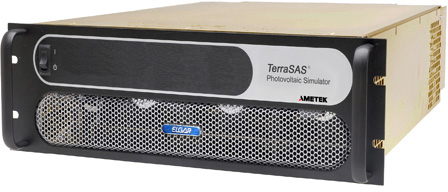TerraSAS leading the market in PV Simulation
TerraSAS leading the market in PV Simulation
From agriculture to Satellites in space, we rely on the power of the sun. When working with a PV solar system, efficiency is one of the main focuses.
Solar power is a complex system with forces outside of our control that constantly changes the irradiance. With every movement of clouds, intensity of the sunlight or temperature of the solar panels, your current voltage curve changes, and the load characteristics you require will need to be tweaked to ensure you are transferring power at the highest efficiency.
Common PV simulators have a large capacitor on its output as a part of their output regulation. This however also suppresses the AC ripple generated by a typical Solar inverter on their DC input line. For accurate MPPT, this is an issue and will affect the efficiency of the system.
Introducing the TerraSAS PV Simulator
The AMETEK TerraSAS PV Simulator, is designed with MOSFET for much higher switching frequency compared to the traditional IGBT, which results in smaller output capacitors and inductors resulting speed improvement of 10 times.
With the capability of reproducing voltage current behaviour of a solar array at the ripple frequency, you will not only be able to accurately use traditional techniques such as perturbate and observe, but also take advantage of the amplitude and phase of the voltage and current measurements to quickly find the MPP.
Get in touch with Fuseco to find out more!
Product Spotlight: TerraSAS
Features & Benefits
- Low output capacitance.
- High bandwidth up to 30kHz.
- High resolution I-V curve simulates static and dynamic conditions.
- Designed for high-speed Maximum Power Point Tracking (MPPT).
- Can be integrated into a multi-channel system for high power testing.
- Low voltage, high bandwidth version for DC Power Optimizers.
- EN50530 Support.
Elgar TerraSAS Overview
Why Fuseco?
Fuseco are the leading experts in Test Equipment across Australia. We are partners with some of the world’s leading suppliers in Test Equipment which allows us to provide our clients with the highest-quality products. We can be active participants in those crucial early concept phase discussions regarding the various solutions available.
Please contact the team at FUSECO for further information and completive pricing for all your Test Equipment requirements.
We're here to help
Talk to an expert today.
Our friendly team of highly trained specialists will quickly assist you.
We promise to respond within 4 business hours (AEST).
Or you will receive $100 off your next purchase. Read how it works.
Top FAQs
When purchasing a power supply, the first choice to be made is linear supply or switching supply. Linear power supplies offer low ripple and noise specifications and have fast transient behavior. However they are inefficient and generate a lot of heat. They are also quite heavy. As a result most engineers prefer linear power supplies for low power applications. Using switching power supplies is a better choice for higher output power or multichannel applications. They provide higher power density. Switching power supplies are easier to control than linear supplies and cost about the same per channel.
Transient response is a measure of how well a power supply copes with changes in current demand or how well the supply follows the changes in the load impedance. This is an important specification for many applications.
DC output voltage slew rate is a rise or fall time. DC programmable power supplies have output filters that use large capacitors that store a lot of energy. It’s mainly the charge and discharge time of this filter, combined with the current demand of the DUT, which determine a supply’s voltage slew rate. The voltage slew rate is mostly independent of the connected EUT.
Load Regulation is an important specification of programmable power supplies. This means some percent output voltage change from its set-point due to a change in the current demand of the EUT. Normally this effect should be very small, less than 0.01% of set output voltage.
Line regulation specifies the percent change of the DC output voltage or current as a function of AC input line voltage. This specification is important when the input line voltage is not stable.
Stability is a measure of a supply’s long term output voltage or current drift. Stability is primarily specified in parts per million or ppm.
If more output current is required then paralleling power supply outputs is generally the solution. Ametek Programmable Power uses a dedicated control bus to connect its power supplies in parallel. The system configures itself automatically, identifying which unit is the master and which units are the slaves.
If more output voltage is required then connecting power supplies outputs in series is generally the solution. All you have to do is to connect the positive terminal of one supply to the negative of another. The limitation is that when operated in series, there are no master and slave units. Individual power supplies has to be programmed.
DC programmable power supplies typically provide a standard and isolated analog interface. Through the analog interface a supply’s DC output voltage, current and over voltage protection can be set. The control signal can be a voltage signal, a current signal or by connecting a resistor to the analog input.
Many DC programmable power supplies can be configured for either local or remote sensing. For a more accurate output voltage setting, remote sensing should be use. This method compensates for the voltage drop across the leads to the load terminals.

Upgrading to the Asterion power supply system has given us significant more testing capability and flexibility. It has been a wise investment. Thank you for your advice and support.
Margaret Smith
TEST LABORATORY SENIOR ANALYST AT UNIVERSITY OF NSW

Buying the MX45 California Instruments power source has given us enhanced testing capabilities. We have the SNK option, which is a bidirectional sink option. We are now able to simulate all grid conditions in our lab environment up to 45kVA. For me, reliability is important and I’m happy to say that we have been using this device for many years without any issues.
Keith Boydell
RESEARCH FELLOW AT UNIVERSITY OF WOLLONGONG

We have several Sorensen power supplies in our lab and they are the lowest output noise power supply we have experienced. For any critical research project where output noise and line/load regulations are important, we use only Sorensen power supplies.
Annette Eskdale
TEST LABORATORY MANAGER AT MONASH UNIVERSITY
Technical Support
Our experts are all pre-eminent leaders in electrical products who provide excellent support in their areas of expertise.
Technical supportTalk to an expert
Our friendly team are highly trained product experts who really enjoy helping customers find what they need.
call 1300 387 326Enquire by email
We promise to respond within 4 business hours (AEST) or you will receive $100 off your next purchase.
Enquire now
